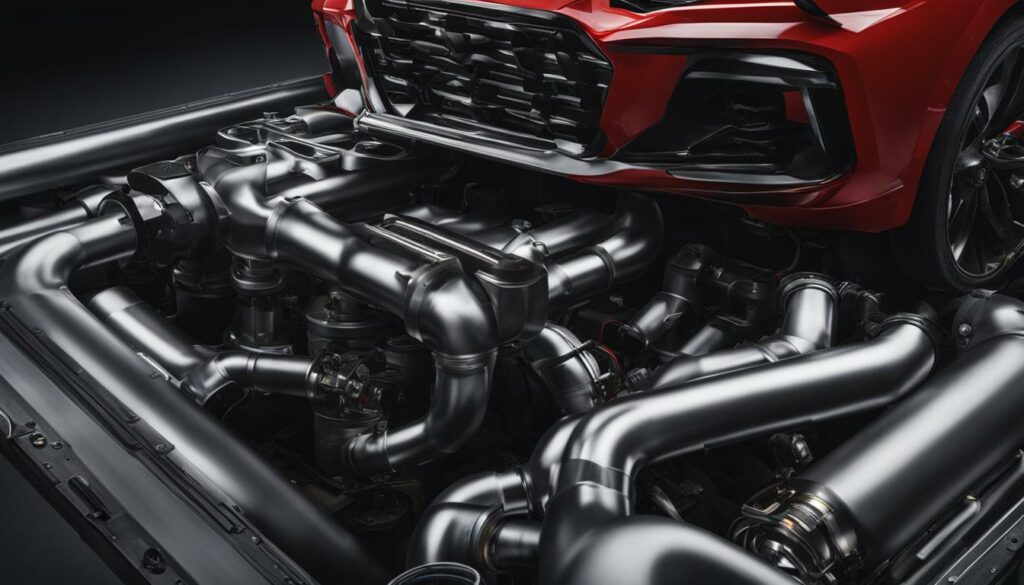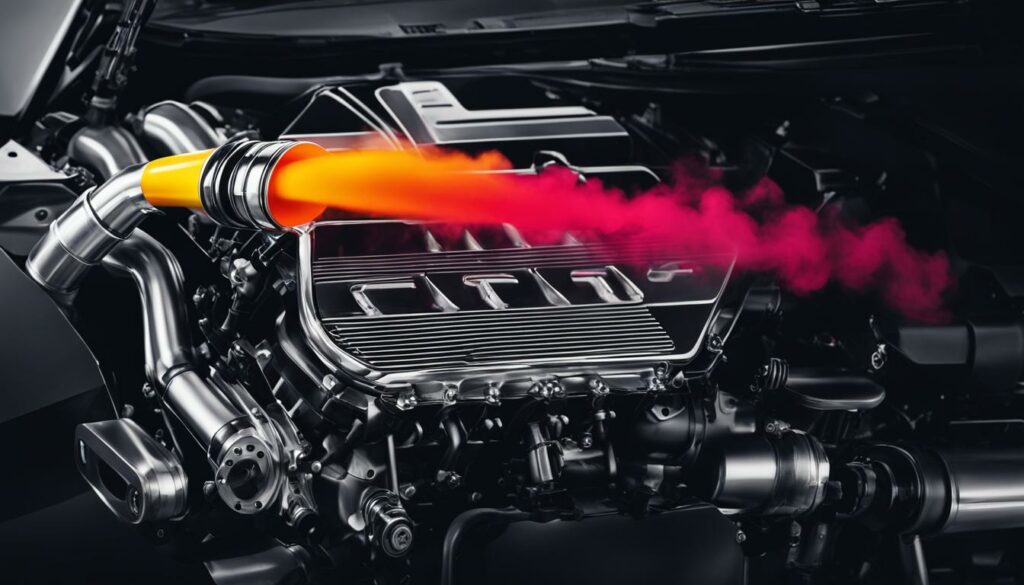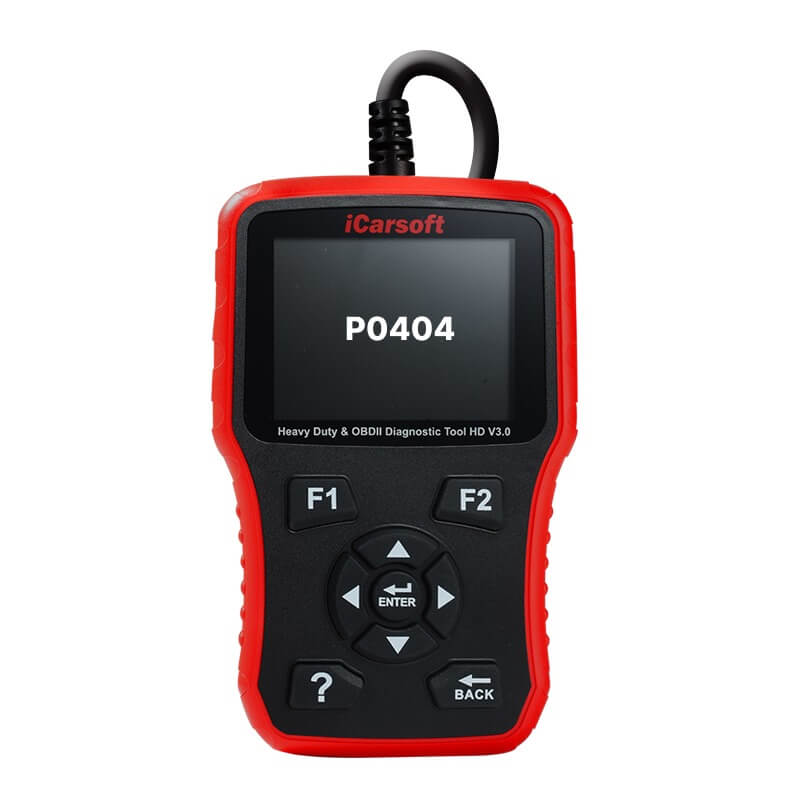P0404 – Exhaust Gas Recirculation Circuit Range/Performance
POSTED IN pcodes
Welcome to our article on the P0404 code – Exhaust Gas Recirculation Circuit Range/Performance. If you’ve encountered this diagnostic trouble code (DTC) in your vehicle, it indicates a potential issue with the exhaust gas recirculation (EGR) system. Don’t worry, we’re here to help you understand what this code means, its potential causes, symptoms to look out for, and how to diagnose and fix the problem. Let’s dive in!
Key Takeaways:
- The P0404 code indicates a potential issue with the EGR system in your vehicle.
- Causes of a P0404 code include a dirty or malfunctioning EGR valve, wiring issues, faulty EGR position sensor, carbon buildup, or PCM problems.
- Symptoms may include an illuminated check engine light, rough running, high NOx emissions, and decreased fuel economy.
- To diagnose a P0404 code, perform a systematic diagnosis, including checking for additional DTCs and inspecting the EGR valve and sensor.
- Fixing a P0404 code involves cleaning or replacing the EGR valve, addressing wiring or sensor issues, and potentially updating the PCM software.
What Does a P0404 Code Mean?
The P0404 code stands for “Exhaust Gas Recirculation Circuit Range/Performance.” When the PCM triggers this code, it means that the EGR valve is performing outside the expected parameters. The EGR system is responsible for directing exhaust gases back into the engine cylinders to reduce emissions and lower cylinder temperatures. The EGR valve communicates with the PCM to let it know if the valve is open, closed, or partially closed. A P0404 code can indicate that the valve is closed when it should be open or vice versa.
An EGR valve that is closed when it should be open can disrupt the proper flow of exhaust gases, potentially leading to increased emissions and higher cylinder temperatures. On the other hand, if the valve is open when it should be closed, it may result in improper combustion and reduced engine efficiency.
It’s important to pay attention to a P0404 code as it can affect your vehicle’s performance and emissions.
To fix the issue and clear the P0404 code, it’s crucial to diagnose the exact cause of the EGR valve’s abnormal performance. This may involve inspecting the valve for any mechanical issues, checking the wiring and connections, and testing the EGR position sensor for faults. Once the cause is identified, appropriate repairs or replacements can be made to restore the EGR system’s proper functioning.
Buy tested tuning file for Adblue / EGR / DPF / Adblue off now!
Common Symptoms of a P0404 Code
- Illuminated check engine light
- Rough running and erratic idling
- Increased NOx emissions
- Possible stalling
- Decreased fuel economy
If you experience any of these symptoms along with a P0404 code, it’s essential to address the issue promptly to prevent further damage to the EGR system and ensure optimal engine performance.
Potential Causes of a P0404 Code
When your vehicle’s PCM triggers a P0404 code, it indicates a potential issue with the exhaust gas recirculation (EGR) system. Several factors can lead to the P0404 code, including:
- Dirty or malfunctioning EGR valve: A buildup of carbon or a faulty valve can prevent the EGR system from functioning properly.
- Grounded or shorted wiring: Wiring issues can disrupt the communication between the EGR valve and the PCM, leading to performance problems.
- Faulty EGR position sensor: If the sensor responsible for monitoring the EGR valve’s position malfunctions, it can cause the P0404 code.
- Damage to the wiring or connection problems: Any damage to the wiring or connection leading to the EGR sensor can interfere with its proper function and trigger the P0404 code.
- Erratic movement in the EGR valve: If the EGR valve does not open or close as expected, it can lead to a performance issue in the EGR system.
- Carbon buildup on the EGR valve: Over time, carbon buildup can accumulate on the EGR valve, impeding its movement and causing the P0404 code.
- Problem with the PCM: In some cases, a problem with the powertrain control module (PCM) can be the underlying cause of the P0404 code.
To accurately diagnose the specific cause of the P0404 code, a thorough inspection and testing of the EGR system components, wiring, and PCM may be necessary.
Quote:
“The potential causes of a P0404 code range from simple issues like a dirty EGR valve to more complex problems with the wiring or PCM. It is crucial to identify and address the root cause to prevent further damage and ensure optimal engine performance.”
A comprehensive understanding of the potential causes of a P0404 code is essential for a successful diagnosis and repair process. Next, we will explore the symptoms commonly associated with this code to further assist in identifying and resolving the issue.

P0404 Code Symptoms
If you’re experiencing a P0404 code in your vehicle, there are several symptoms that you may notice:
- Check Engine Light: The most obvious symptom is the illumination of the check engine light on your dashboard. This serves as an early warning sign that something is amiss with your vehicle’s exhaust gas recirculation (EGR) system.
- Rough Running and Erratic Idling: A P0404 code can lead to rough running and erratic idling. You may notice that your vehicle’s engine doesn’t run as smoothly as it should.
- High NOx Emissions: NOx emissions refer to nitrogen oxides, which are harmful pollutants that contribute to air pollution. If your vehicle’s EGR system is not functioning properly, it can result in higher levels of NOx emissions.
- Possible Stalling: In some cases, a P0404 code can cause your vehicle to stall unexpectedly. This can be a safety concern, especially if it happens while driving.
- Decreased Fuel Economy: A malfunctioning EGR system can also lead to decreased fuel efficiency. If you notice that you’re getting fewer miles per gallon than usual, it could be a sign of a P0404 code.
It’s important to address these symptoms promptly to prevent further damage to your vehicle and ensure optimal engine performance.
Image: Visual representation of a vehicle engine with the P0404 code displayed on the dashboard.
Diagnosing a P0404 Code
When dealing with a P0404 code, it is crucial to follow a systematic diagnostic process to accurately identify the underlying issue. This involves ruling out other potential problems, checking for any additional diagnostic trouble codes (DTCs), evaluating the freeze-frame data stored in the powertrain control module (PCM), inspecting the EGR valve for any carbon buildup, and testing the EGR sensor for any potential failures.
By following these steps, you can pinpoint the exact cause of the P0404 code and develop an effective repair plan. Let’s explore each diagnostic procedure in detail.
Ruling out other potential issues
Before diving into the specific components of the EGR system, it’s important to rule out any other potential issues that may trigger the P0404 code. Some common problems that can mimic the symptoms of a faulty EGR system include vacuum leaks, fuel system issues, or engine misfires. By conducting a thorough inspection and ruling out these possibilities, you can ensure an accurate diagnosis.
Checking for additional DTCs
In addition to the P0404 code, there may be other DTCs stored in the PCM that can provide valuable information about the overall health of the vehicle’s systems. By scanning for and addressing these additional DTCs, you can prevent any potential complications and ensure a comprehensive repair.
Evaluating PCM freeze-frame data
The PCM freeze-frame data captures the specific conditions that were present when the P0404 code was triggered. This includes relevant engine parameters such as RPM, engine load, and coolant temperature. By analyzing this data, you can gain valuable insights into the circumstances surrounding the code and potentially identify any patterns or correlations that can aid in the diagnostic process.
Inspecting and cleaning the EGR valve
The EGR valve is a critical component of the EGR system, responsible for controlling the flow of exhaust gases into the intake manifold. Over time, carbon buildup can accumulate on the valve, hindering its proper operation and triggering the P0404 code. By carefully inspecting the valve for any signs of carbon deposits, you can determine if cleaning or replacement is necessary.
Testing the EGR sensor
The EGR sensor works in conjunction with the EGR valve to provide feedback to the PCM about the position and operation of the valve. Testing the sensor involves using a multimeter to measure its resistance and ensuring that it responds correctly to changes in the valve’s position. By conducting this test, you can identify any potential failures in the sensor and accurately determine if it needs to be replaced.
Summary of Diagnostics Procedures for a P0404 Code
| Diagnostic Procedure | Description |
|---|---|
| Ruling out other potential issues | Inspect for vacuum leaks, fuel system problems, or engine misfires that can mimic EGR system issues |
| Checking for additional DTCs | Scan PCM for any additional diagnostic trouble codes and address them accordingly |
| Evaluating PCM freeze-frame data | Analyze the freeze-frame data to understand the conditions when the P0404 code was triggered |
| Inspecting and cleaning the EGR valve | Visually inspect the EGR valve for carbon buildup and clean or replace if necessary |
| Testing the EGR sensor | Use multimeter to measure the resistance of the EGR sensor and ensure proper operation |
How to Fix Code P0404
Fixing a P0404 code starts with a correct diagnosis. If the issue is determined to be a dirty EGR valve, cleaning the valve may be sufficient to remove the code. Other possible repairs include repairing open or shorted wiring leading to the EGR sensor, replacing the EGR position sensor, replacing the EGR valve, or checking the PCM and updating the software if required.
Note: It is important to address the underlying issue causing the P0404 code to prevent further damage to the EGR system.
Recommended Steps:
- Perform a thorough diagnosis to determine the cause of the P0404 code.
- If the EGR valve is dirty, clean it to remove any carbon buildup.
- Inspect the wiring leading to the EGR sensor for any open or shorted connections. Repair as necessary.
- If the EGR position sensor is faulty, replace it with a new one.
- If the EGR valve itself is malfunctioning, replace it with a new one.
- Check the PCM and update the software if recommended by the manufacturer.
By following these steps, you can effectively address the P0404 code and ensure proper functioning of the exhaust gas recirculation (EGR) system in your vehicle.
EGR Valve Cleaning Process:
| Materials Needed: | Steps: |
|---|---|
|
|
Choosing Hot Shot’s Secret Additives for Your Vehicle
When it comes to addressing common vehicle issues and diagnostic trouble codes (DTCs) like P0404 – Exhaust Gas Recirculation Circuit Range/Performance, Hot Shot’s Secret Additives is your go-to solution. With their range of high-quality fuel additives, Hot Shot’s Secret can help keep your vehicle performing at its best and prevent issues related to the exhaust gas recirculation (EGR) system.
Two of their most effective products for combating carbon buildup on the EGR valve and enhancing EGR valve performance are the Diesel Extreme and Everyday Diesel Treatment.

Hot Shot’s Secret Diesel Extreme is scientifically proven to significantly slow down carbon buildup on the EGR valve in diesel engines. By effectively reducing carbon deposits, it helps to optimize the functioning of the EGR system and improve overall engine performance.
The Everyday Diesel Treatment from Hot Shot’s Secret is another excellent option for keeping your EGR valve in top condition. This additive has been specifically formulated to clean and lubricate the fuel system, reducing the likelihood of carbon buildup and ensuring optimal EGR valve performance.
By incorporating Hot Shot’s Secret Diesel Extreme or Everyday Diesel Treatment into your regular maintenance routine, you can proactively prevent carbon buildup and prolong the life of your EGR system. These fuel additives offer a cost-effective and reliable solution for improving performance and preventing issues related to the EGR system.
| Fuel Additives | Key Benefits |
|---|---|
| Diesel Extreme | – Significantly reduces carbon buildup on the EGR valve – Enhances EGR valve performance – Improves overall engine performance |
| Everyday Diesel Treatment | – Cleans and lubricates the fuel system – Prevents carbon buildup on the EGR valve – Ensures optimal EGR valve performance |
Conclusion
In conclusion, if you encounter a P0404 code in your vehicle, it is an indication of a potential problem with the exhaust gas recirculation (EGR) system. Taking prompt action to diagnose and address the underlying issue is crucial to prevent further damage and ensure optimal engine performance.
Diagnosing the problem may involve inspecting and cleaning the EGR valve, replacing faulty wiring or sensors, and updating the PCM software if necessary. It is important to follow a systematic approach to accurately pinpoint the cause of the P0404 code.
Additionally, using Hot Shot’s Secret additives can provide a preventive solution for carbon buildup on the EGR valve. Their scientifically proven Diesel Extreme and Everyday Diesel Treatment can significantly improve EGR valve performance and overall engine performance. Consider incorporating these additives into your routine maintenance to maintain a clean and efficient EGR system.
FAQ
What does a P0404 code mean?
A P0404 code indicates a potential issue with the exhaust gas recirculation (EGR) system in a vehicle. It means that the EGR valve is not performing within the expected parameters, either being closed when it should be open or vice versa.
What are the potential causes of a P0404 code?
The common causes of a P0404 code include a dirty or malfunctioning EGR valve, grounded or shorted wiring, a faulty EGR position sensor, carbon buildup on the EGR valve, or a problem with the PCM (Powertrain Control Module).
What are the symptoms of a P0404 code?
Symptoms of a P0404 code may include an illuminated check engine light, rough running and erratic idling, high NOx emissions, possible stalling, and decreased fuel economy.
How is a P0404 code diagnosed?
Diagnosing a P0404 code involves ruling out other potential issues, checking for additional DTCs, evaluating the PCM’s freeze-frame data, inspecting and cleaning the EGR valve for carbon buildup, and testing the EGR sensor for potential failures.
How can a P0404 code be fixed?
Fixing a P0404 code starts with a correct diagnosis. Possible repairs include cleaning the EGR valve, repairing wiring or connection problems, replacing the EGR position sensor or the EGR valve, or checking the PCM and updating the software if required.
Why should I choose Hot Shot’s Secret additives for my vehicle?
Hot Shot’s Secret additives, such as Diesel Extreme and Everyday Diesel Treatment, can help prevent and address carbon buildup on the EGR valve, improving overall EGR system performance and engine performance.


